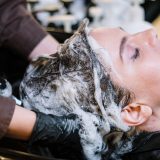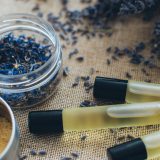Say no to Sulfates and Silicones for juicy and defined curls

Avoiding sulfates and silicones is the number one tenet of the Curly Girl Method (CGM) and is key to achieving the coveted moisture/protein balance that curly hair thrives on. See below for the list of sulfates and silicones to avoid (spelling variations are excluded from these lists)
Say no to Sulfates
A sulfate is a cleansing agent and surfactant that can be found in household cleaners, detergents and shampoos. The two biggies that many shampoos contain are Sodium Lauryl Sulfate (SLS) and Sodium Laureth Sulfate (SLES). These and other sulfates create the lathering effect that removes dirt and oil from your hair and scalp. Sounds great, but these harsh sulfates can disrupt the moisture/protein balance by stripping the hair of it’s natural oils. Long-term daily use of a sulfate shampoo can create dry, frizzy and undefined curls.
Say no to Silicones
Silicones are polymers that are meant to provide slip and shine while taming frizz. Wonderful, right? Unfortunately, these silicones can build up on the hair over time and create a residue barrier, which blocks moisture from reaching the hair shaft. The only way to remove silicones is with a sulfate shampoo, which can strip the hair. Endless cycle begins and no moisture/protein balance can be achieved.
Always avoid both sulfates and silicones
Scenario 1: Sulfate shampoo followed by silicone conditioner and stylers. The shampoo strips the hair and the silicones block the moisture. This creates an endless cycle leaving you with dry, frizzy, lifeless hair.
Scenario 2: Sulfate-free shampoo followed by silicone conditioners and stylers. The sulfate free shampoo is not strong enough to remove the silicones from the hair. The silicones will eventually create an almost plastic-like barrier – no moisture can get in. Ugh … another formula for dry, frizzy lifeless hair.
Scenario 3: Sulfate-free shampoo and silicone free conditioner and stylers (otherwise known as the Curly Girl Method). Gentle cleansing or cowashing does not strip the hair of natural oils. Moisture can penetrate the hair shaft allowing the moisture/protein balance to thrive and curls become juicy and defined! Yay!
Sulfates that should be avoided:
- Alkylbenzene sulfonates
- ammonium cocoyl sulfate
- ammonium dodecyl sulfate
- ammonium laureth sulfate
- ammonium lauryl sulfate
- ammonium salt
- ammonium xylene-sulfonate
- dioctyl sodium sulfosuccinate
- ethyl peg-15 cocamine sulfate
- monododecyl ester
- sodium alkyl sulfate
- sodium c12-18 alkyl sulfate
- sodium cetearyl sulfate
- sodium coceth sulfate
- sodium coco sulfate
- sodium laureth sulfate
- sodium laureth-40 sulfate
- sodium lauryl sulfate
- sodium myreth sulfate
- sodium polystyrene sulfate
- sodium xylene-sulfonate
- tea dodecylbenzenesulfonate
- tea lauryl sulfate
- tea-dodecylbenzenesulfonate
- triethanolamine lauryl sulfate
Silicones that should be avoided:
- Dimethicone
- Bisaminopropyl dimethicone
- Cetearyl methicone
- Cetyl Dimethicone
- Cyclopentasiloxane
- Stearoxy Dimethicone
- Stearyl Dimethicone
- Trimethylsilylamodimethicone
- Amodimethicone
- Dimethiconol
- Behenoxy Dimethicone
- Phenyl trimethicone
- Aminopropyl Triethoxysilane
- Trimethylsiloxyamodimethicone
- Polysilicone-15
- Parsol SLX
- Bis-Amino PEG/PPG-41/3 Aminoethyl PG-Propyl Dimethicone
Too many ingredients to remember. Use Is it CG?
The easiest way to analyze all of the different ingredients in your hair products is to use the Is It CG? app. Simply paste the ingredients into the app and it will automatically analyze them and provide a breakdown of what each ingredient will do for your hair. Good or Bad!

